Safety officers in Construction Sites
Every day the work environment is increasing rapidly and becoming complex in construction, manufacturing, rigs, oil and gas, offshore, and other industries. In the workplace, the Safety Officer duties and responsibilities have become paramount in ensuring the health, safety, and well-being of workers and compliance with local and international regulatory standards. For professionals looking to enhance their workplace safety and improve workplace safety culture, understanding the Safety Officer duties and responsibilities is the most important thing to be more effective and straightforward in your duty.
Safety Officer Job Description
A safety officer is typically an individual (employee) who is directly responsible for ensuring compliance with occupational health and safety standards in the workplace. Every workplace consists of specific risks and hazards to minimize and control these risks. The safety officer conducts risk assessments, inspects the workplace, and checks equipment and facilities to avoid incidents and promote the workplace. Safety IS the key responsibility of a safety officer.
In this blog, I will delve into the main and most common duties and responsibilities of safety officers and will also highlight their importance in risk management and empowering workplace safety. After reading these responsibilities, the professionals will be able to understand the main tasks they need to perform.
Qualifications and Skills
A common question most people ask regarding qualifications and skills, what does a safety officer have to have? Here are the minimum qualifications and skills a safety officer must have:
- Intermediate or Bachelor in Science or Engineering
- Professional certifications like NEBOSH IGC and OSHA are mandatory, while IOSH, ISO, ASP, CSP, OTHM, NVQ, etc. can be considered as additional.
- Fluent in English and effective communication skills.
- Reporting and Investigation.
- Documentation and Microsoft Office Skills.
- Ability to manage the site and train the workers.
- Planning and leadership skills.
- 3 to 5 years of experience in a relevant field.
Here is the complete discussion for professionals related to Safety Officer Course
Duties and Responsibilities of Safety Officer
|
Duties and Responsibilities |
Description |
|
1. Risk Assessment and Hazard Identification |
|
| 2. Equipment Records and Operators Competency |
|
|
3. Policy Development and Implementation |
|
|
4. Incident Investigation and Reporting |
|
|
5. Compliance Monitoring |
|
|
6. Communication & Coordination with Management |
|
|
7. Safety Equipment and PPE |
|
|
8. Emergency Preparedness |
|
| 9. Continuous Improvement |
|
| 10. Attend Safety Meeting and Audits |
|
In different industries or companies, scope-based responsibilities may vary. In some cases:
-
In construction, safety officers focus heavily on site inspections, fall protection, equipment safety, excavation, warehouse and transportation.
-
In manufacturing, they emphasize machine guarding, chemical safety, and lockout/tagout procedures.
-
In offices, they may prioritize ergonomics, fire safety, and mental health support.







